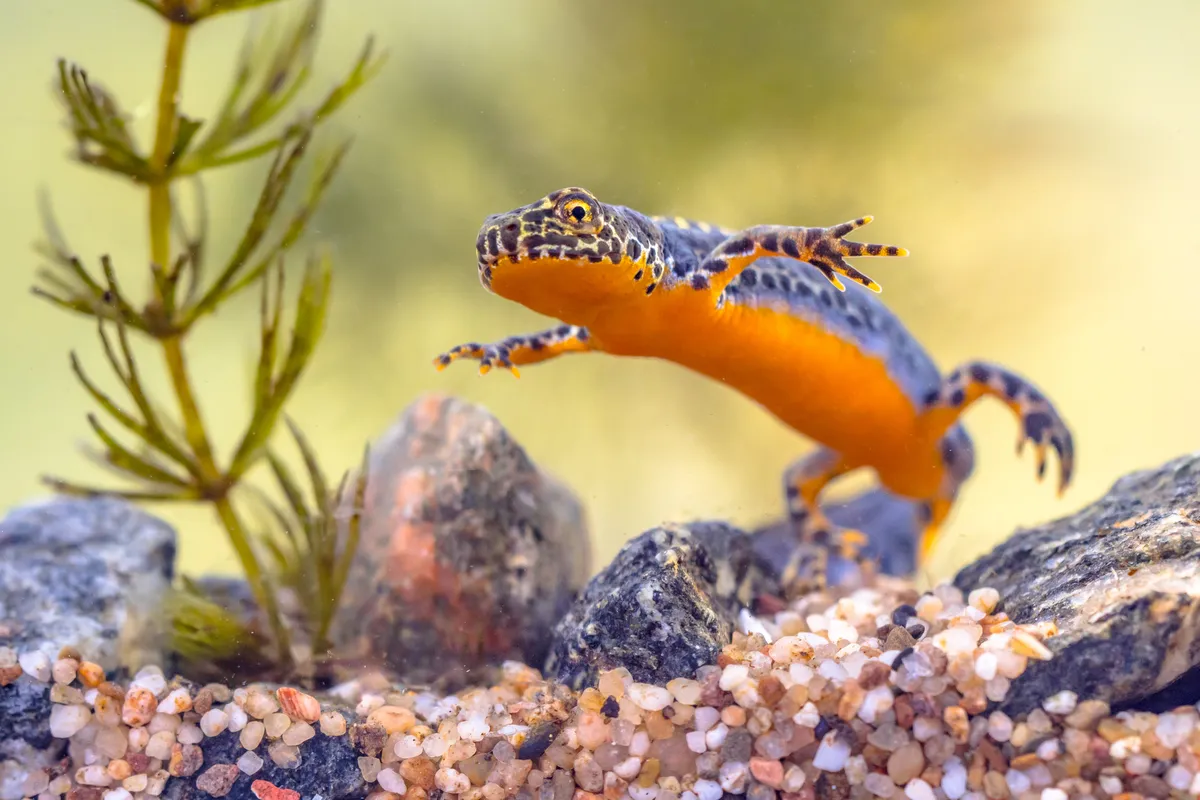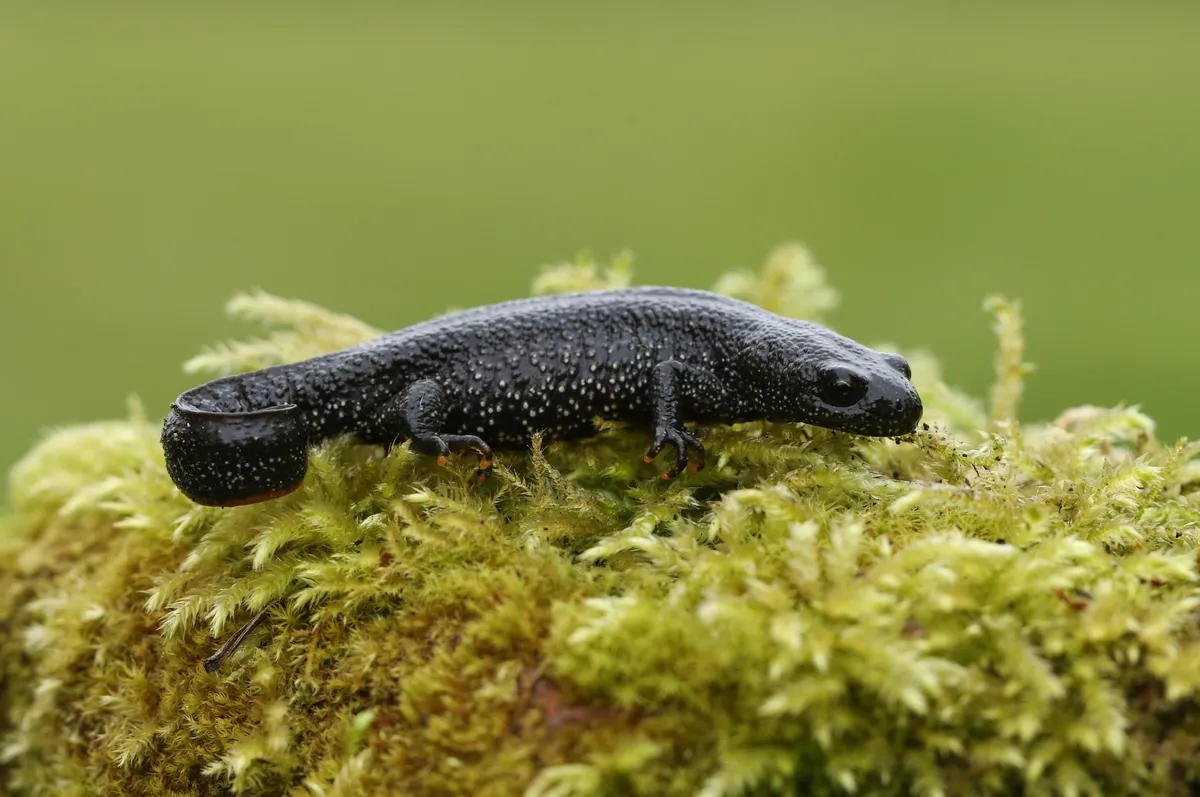Alpine newts are a striking species, with marbled skin and bright spot-free orange bellies. They are similar in appearance to great crested newts, though they are smaller in size.
They are an introduced non-native species in the British Isles, first recorded in Surrey in the 1920s. They are widespread, but not common, in England and Scotland.
The species is a known carrier of both types of chytrid fungi, which can be fatal to amphibians.
Learn more about alpine newts in our expert guide by PhD scientist Steve Allain:
What is an alpine newt?
Alpine newts are a species of newt, which are a type of amphibian, native to continental Europe that were introduced to Great Britain during the last century. The first alpine newts were recorded in Newdigate, Surrey during the 1920s. Since then they have become increasingly widespread throughout England and Scotland.
As their name suggests, alpine newts can tolerate high altitudes (up to 2,370 m) although they can be found all the way down to sea level throughout both their native and introduced ranges.
What is the scientific name of the alpine newt?
The scientific name of the alpine newt is Ichthyosaura alpestris.
How to identify alpine newts
Alpine newts are a medium sized newt with adults measuring up to 12 cm in length, the females are larger than males. Both sexes are dark grey in colour on the flanks, sometimes with some marbling to the skin. They have a bright orange belly that is usually free from any sort of patterns or marking.

Males are more flamboyant with blue flanks bordered by black spots contained with a white band running the length of the body. Males in the breeding season can also be identified by the presence of a short black and yellow striped crest.
Alpine newts grow bigger than both smooth newts and palmate newts, which can be found in the areas where alpine newts have been introduced. They’re also smaller than great crested newts (pictured below).
If you’re not confident on identifying newts based on size alone, the best way to identify them is to look at their underside. The belly and chin area of alpine newts should be a bright vibrant orange with few spots (if any).

Where are alpine newts native to?
Alpine newts can be found throughout continental Europe from northwestern France to the Romania, and from southern Denmark to the Alps. They also occur throughout the Balkans and Greece.
Where did the alpine newts come from?
For some time alpine newts were a popular pet species due to their ease of keeping. Most of the animals imported into Great Britain were of the Apennine alpine newt (I. a. apuana) subspecies as the males are highly attractive compared to other subspecies (although this may itself be its own species). Either due to intentional releases or through animals escaping captivity, alpine newts found their way into the wild and have proliferated ever since.
Where can alpine newts be found?
Throughout Great Britain, alpine newts can be found in the sort of habitats that you’d expect to find newts such as ponds and lakes. The full extent of their distribution is not currently known with new populations being uncovered all the time.
It is therefore likely that they are more widespread that previously thought. However they tend to occur in or near areas with a high population density such as cities, although rural populations do exist.

What legislation is there regarding alpine newts?
As they are a non-native species in Great Britain, it is illegal to release them into the wild under the Wildlife and Countryside Act (1981). This also includes after capturing them whilst bottle trapping for great crested newts (as an example) or whilst pond dipping. Any captured alpine news should be ethically euthanised or rehomed in captivity assuring that they can’t escape back into the wild.
Are alpine newts endangered?
Due to their extensive range alpine newts are listed as Least Concern by the IUCN Red List. However this may change in the future if species is delimited due to the presence of cryptic species, therefore reducing the range of I. alpestris.
What threats do alpine newts post to the UK's native amphibians?
At the moment there is limited evidence to suggest impacts of alpine newts on our native amphibian species. The likely consequences of their introduction include competition with native newts, which if severe enough could displace species such as smooth and palmate newts. This is unlikely as alpine newts share the same ponds as our native newts throughout their range.
Alpine newts may also act as a disease vector to native species, they are known to be a reservoir for both types of the pathogenic chytrid fungi: the amphibian chytrid fungus (Batrachochytrium dendrobatidis) and the salamander chytrid fungus (B. salamandrivorans). Thankfully B. salamandrivorans is yet to be found in the wild in the British Isles and B. dendrobatidis has limited effects on our native species.
However this may change in the future as populations face increased stress from climate change, habitat loss and other threats. For now the best thing to do is to keep a watchful eye on alpine newts and try to assess their impacts once populations have been identified.
Steven Allain is an avid herpetologist, photographer, researcher and science communicator. His research covers a range of topics, which most recently has involved investigating the population dynamics of grass snakes and the effects of ophidiomycosis.
One of his main missions outside of his research is to communicate the growing need for interest in the conservation of amphibians and reptiles.
Steven also helps to engage members of the public through a number of different means such as via social media and podcasts, to answer their questions about amphibians and reptiles, whilst also reiterating whilst these two groups of animals are vital components of a healthy ecosystem.
Main image: An Alpine newt. © Paul Starosta/Getty
